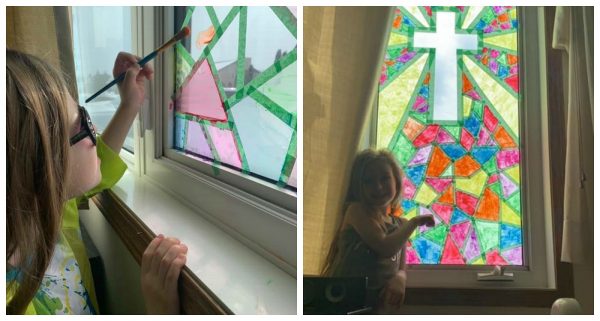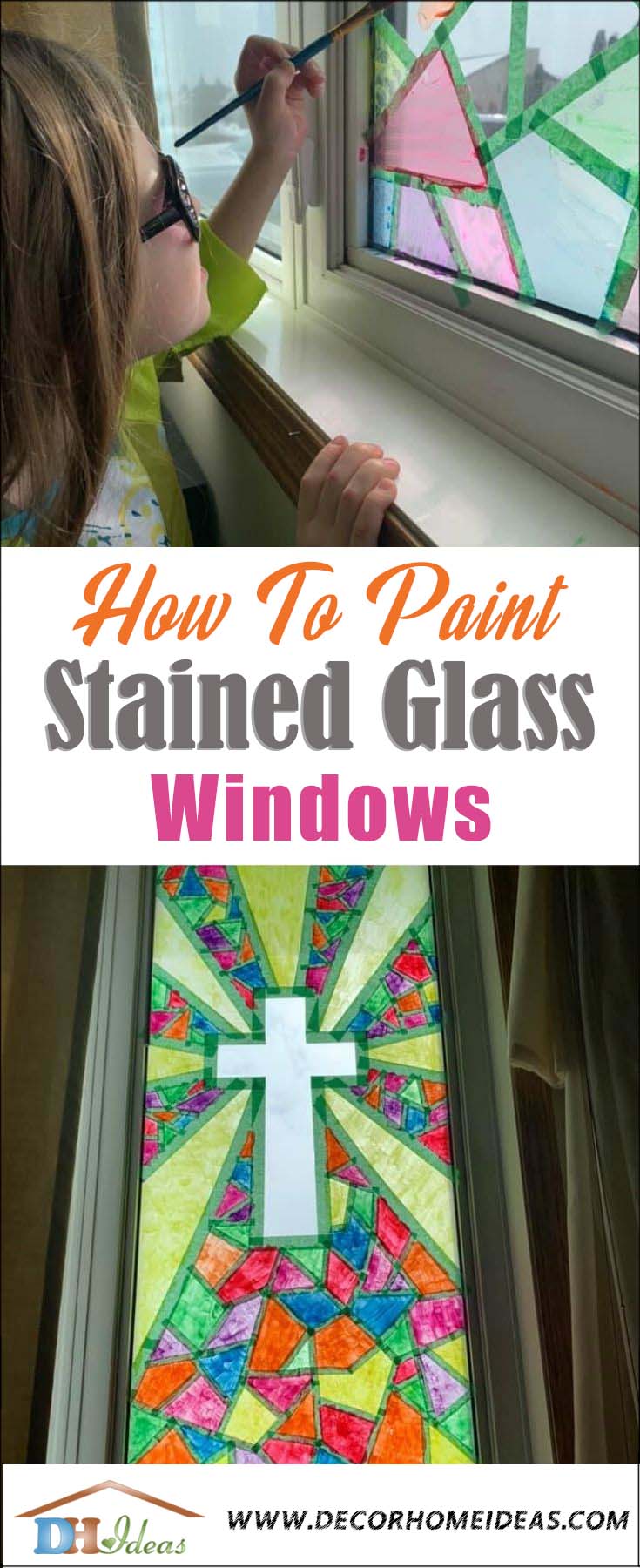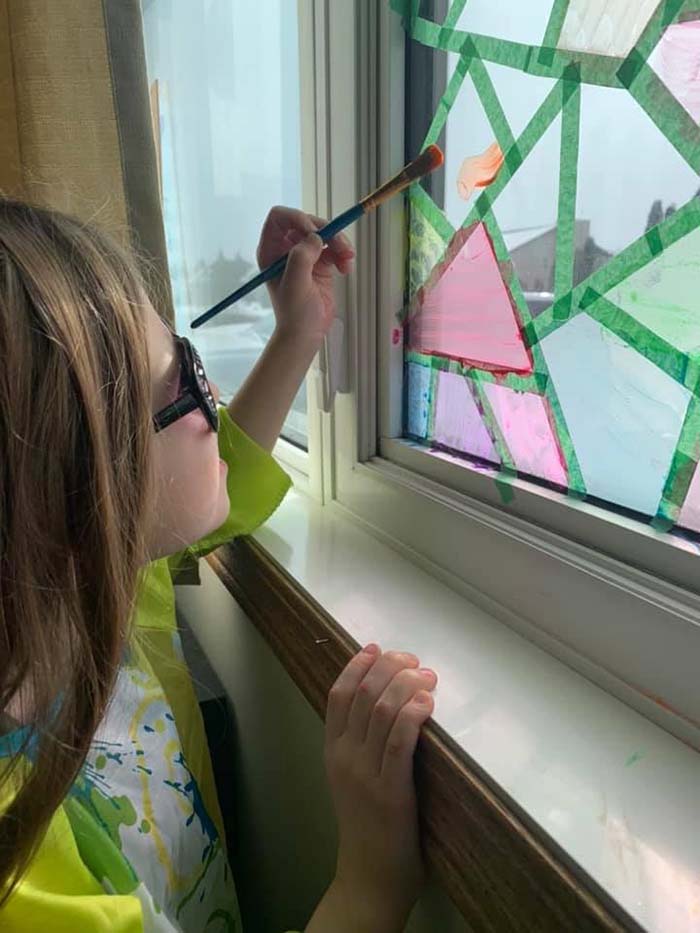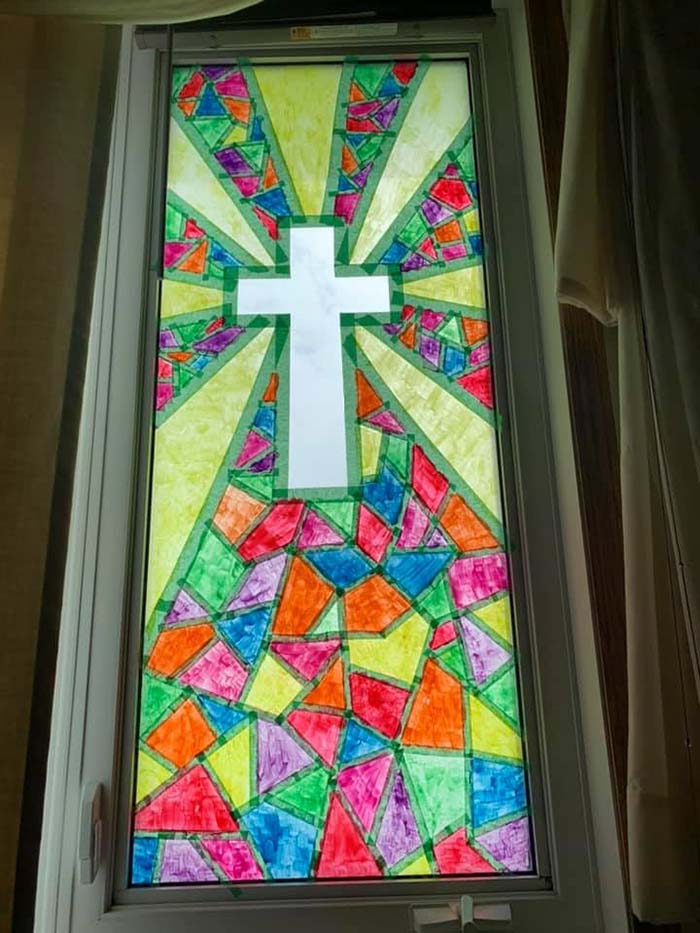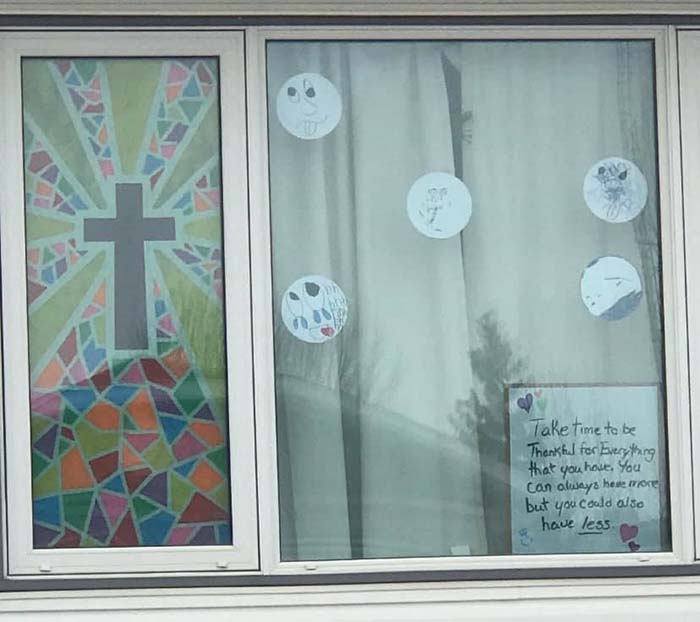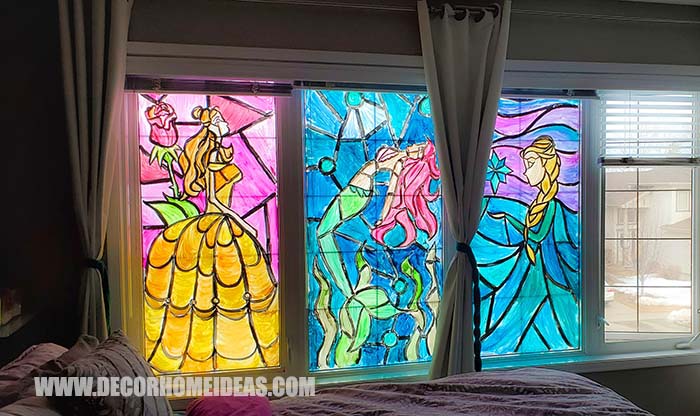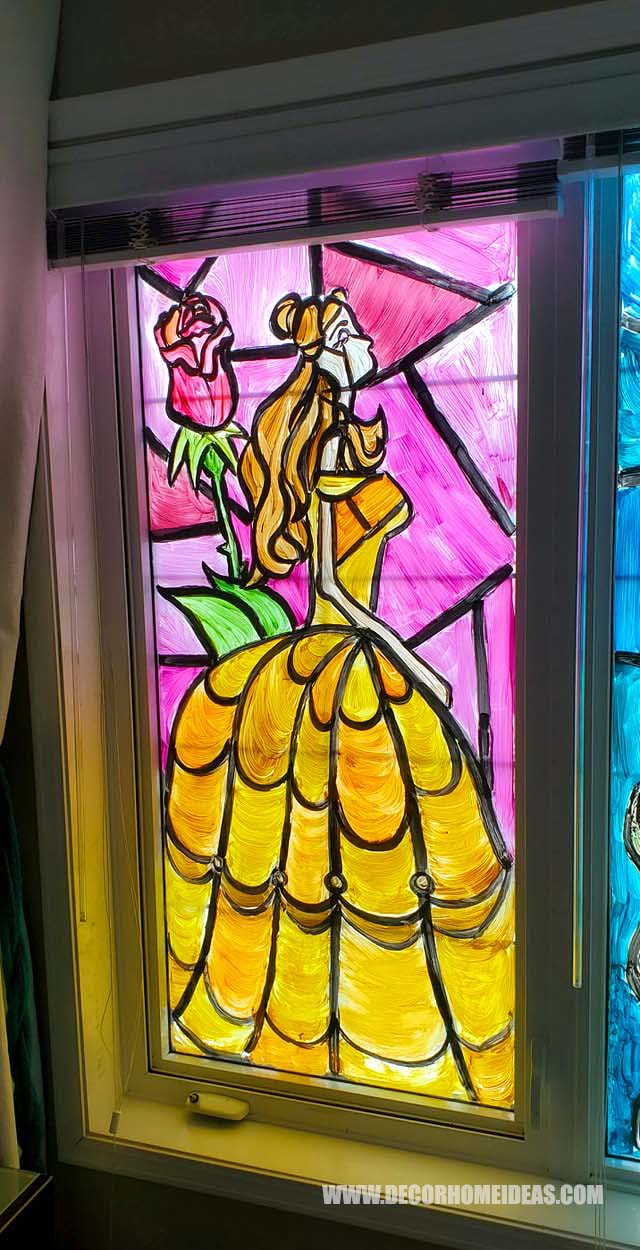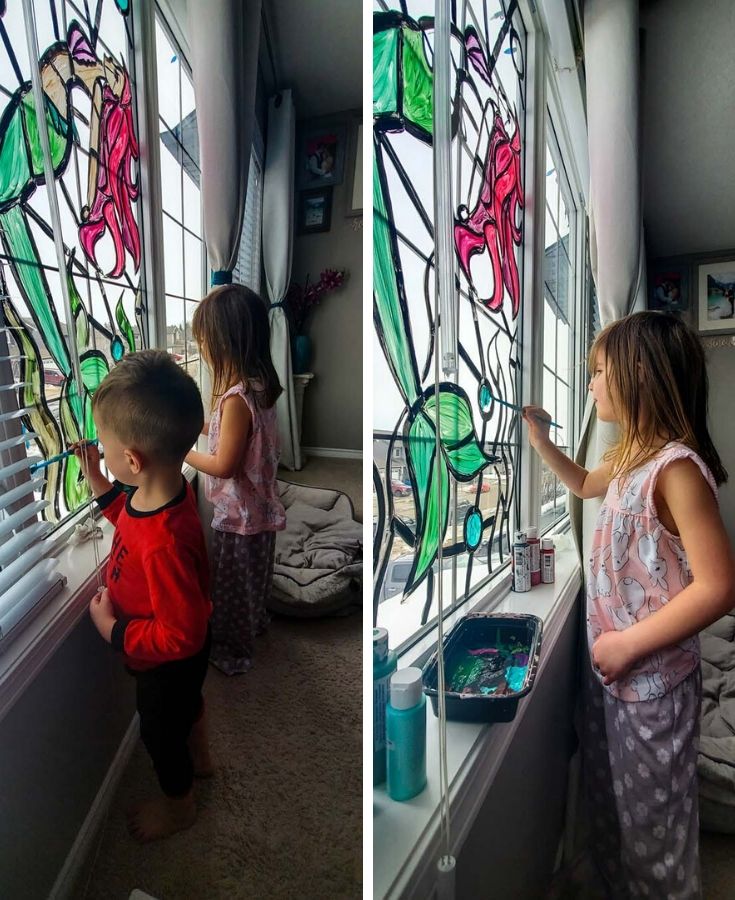- Stained Glass Paint: Which Type of Paint to Use
- Glass Paint
- 1. Folk Art Enamels
- 2. DecoArt Gloss Enamels
- 3. Pebeo — Porcelain 150
- 4. Pebeo — Porcelain 150 — Glass Paint Pens
- 5. Pebeo — Vitrea 160 Outliner
- 6. Traditional Stainer Paints — Reusche
- In My Experience.
- Share this:
- Related posts
- Stained Glass Paint: Which Type of Paint to Use
- Paint Your Own Stained Glass Windows
- DIY Stained Glass
- More Stained Glass Window Ideas
Stained Glass Paint: Which Type of Paint to Use
There are a myriad of ways to add details to your stained glass projects including decorative solder, wire work, and glass paint to name a few. But glass painting opens up so many possibilities and many questions along with it.
And so, this article is all about glass painting and which ones to use on stained glass.
Even if you don’t consider yourself a «painter», sometimes you just want to add an eye or a couple of little lines for detail. Or maybe you want to personalize something with a name or are looking for a way to sign your work? The answer could be to use special paints for glass.
Glass Paint
Ever since I started working with stained glass, I wanted to do traditional stained glass painting, but I didn’t start there. There was so much to learn about the making of stained glass that I had to start smaller and with more basic designs and tools.
Over the years I’ve tried many different types of glass craft paints before ever touching traditional stained glass paints. So I thought that I would share my favorite glass paints with you in no particular order.
This post contains affiliate links. By using our affiliate links to do your shopping, you’ll find what you need easily and I may receive a small commission that helps support the blog.
1. Folk Art Enamels
These glass craft paints are an acrylic paint, made by Plaid for glass and ceramics. They come in a variety of colors and in squeeze bottles that are very easy to store. These water based glass paints are non-toxic and can be used by air drying for 21 days or baking the glass in the oven.
As an avid crafter of many different styles of crafts, I was familiar with Folk Art acrylic paints and found that the Folk Art Enamel paints we’re just as easy to use. These glass paints are opaque and are really long lasting after being baked onto the glass in a regular household oven. It would take some intentional scratching with a knife or something sharp to damage the paint.
The nose, flowers and dots on this stained glass bunny were painted with Folk Art Enamel paints for glass.
The green swirls, the toes and the eye were made using Pebeo Porcelain 150 Paint Pen (#4 in this list.)
2. DecoArt Gloss Enamels
The DecoArt Gloss Enamel paints are another type of glass crafting paint that are very easy to use. These water based paints can be baked onto the glass for a dishwasher safe finish. That’s not to say that you should put your stained glass in the dishwasher! Just to be clear, we don’t do this. Okay?
Applied with a paintbrush these paints are easy to clean up with water and are also non-toxic. DecoArt also has quite a few product lines in their enamel paints, including Gloss Enamels , Frost Enamels , Crystal Gloss Enamels , Glass Chalkboard Paint , Glass Stain and many others.
This cloche style lantern was painted using black DecoArt Gloss Enamels . The whimsical design was hand painted with a brush onto the amber glass.
3. Pebeo — Porcelain 150
Pebeo Porcelain 150 paints are another great glass painting product. These colors can be mixed to make your own shades and personalized colours and are cleaned with water. This line of paints also has a special thinner to use if the paint gets a little old and starts to thicken.
The Porcelain 150 paint is left to air-dry for 24 hours and is then baked in the oven to cure the paint.
Although these paints are still very easy to clean up from solid surfaces, it will take a little more time to clean your brushes. The Masters Brush Cleaner cleans them up beautifully, conditions them and is what I use on all of my brushes. Especially my good ones.
This white glass heart was detailed using the Pebeo Porcelain 150 paint in copper . The paint was applied with a sponge over a stencil to create the design.
4. Pebeo — Porcelain 150 — Glass Paint Pens
The Pebeo line also has a glass paint pen dispenser available. The Porcelain 150 Paint Pens are perfect for writing names on Christmas ornaments or doing any other detailed line work if you don’t have great control with a paintbrush.
I personally found that these often dried out if they weren’t used consistently. But even still, the glass paint pens were super convenient when writing names or doing line work.
The eye, toes and green lines were are all painted using the Pebeo Porcelain 150 Paint Pen.
The flowers and blue dots were painted using Folk Art Enamels (#1 in this list.)
5. Pebeo — Vitrea 160 Outliner
These fancy little tubes of paint are a great way to add texture to your painted design.
The Vitrea 160 Outliner tubes have long slender tips for dispensing the paint. They do take a little practice to get a consistently thick line, but once you get knack for using them, they’re a lot of fun to use!
After painting, the glass is left to air-dry for at least 24 hours and then gets baked in the oven to set the glass paint outliner permanently.
NOTE: Be sure the Vitrea 160 Outliner has dried thoroughly BEFORE baking. If it hasn’t, it will cause broken bubbles to appear in the paint while baking which you can’t get rid of.
The lines in the fairy wings were made using Pebeo Vitrea 160 Outliner in pewter . Some small glass seed beads were added to the tips of the lines of glass paint before baking and the painted acted like glue and held them in place!
The face details were painted on using DecoArt Gloss Enamels (#2 on this list.)
6. Traditional Stainer Paints — Reusche
After making stained glass for 5 or 6 years, I ventured into the amazing world of traditional stained glass paints . These paints are kiln-fired and they’re the same type of paint seen in stained glass windows in churches.
These glass paints are layered on top of each other and fired to approximately 1250 degrees in a glass kiln. This basically melts the glass paint into the top surface of the glass.
It’s this ability to layer the glass paint that allows the artist to get more depth in their work. This created the ability to control the amount of light that comes through. And, it it this depth which helps breathe life into their stained glass designs.
SPECIAL NOTE: Many of the traditional stainer paints contain toxins such as lead and cadmium. For this reason, I only use the lead and cadmium-free stainer paints by Reusche.
This lion was painted using traditional stainer paints by Reusche.
If you are interested in pursuing this fascinating type of glass painting, be sure to understand the safety concerns when using traditional glass paint and wear a proper mask or respirator and consider the proper ventilation as well.
In My Experience.
I use a small toaster oven dedicated strictly to crafting to bake my glass paint onto the glass. And anytime you paint on glass, the glass gets baked or fired BEFORE assembling your stained glass project.
I experimented one time with a small candle holder that I painted a couple of quick designs onto using craft glass paint.
I don’t know why, but I never considered the melting point of the solder before putting it in the oven! Needless to say, when I removed the project from the oven, the four sides of glass had all toppled onto the base and the solder had melted all across the metal tray.
In any case, whether you are looking to add only a couple of details like dots or lines, or you’re interested in getting started with traditional glass painting, there are many options for you to find exactly what you need to add your own artistic flair to your stained glass projects.
Share this:
Loved this? Spread the word
About the Author
Samantha’s a passionate creative with varied artistic interests which she loves to incorporate into her glasswork. Working in both stained glass and fused glass, her goal is to help you be creative and think outside the box while teaching skills to make glass crafting easier.
Related posts
Stained Glass Paint: Which Type of Paint to Use
Leave a Reply
I can’t access the download for soldering. What am I doing wrong?
Hi Marge, If you were trying to subscribe using the same email you used for leaving your comment, it doesn’t appear that you’re a registered subscriber. Try this link to subscribe. You should receive a confirmation on the screen once you add your info and submit it, and then you’ll receive the link by email. https://livingsunglass.com/freevideo/
Some truly nice stuff on this site, I love it.
Fantastic. I was wondering about this and you gave me good information. Thank you.
I’m so glad you found this helpful Lolly! Feel free to share anything you make in the Make Stained Glass group on facebook. 🙂
Helpful info on glass paint products!
When baking painted glass, what temp and how long? Thanks, good info.
Hi Nancy, Great question! Each type of paint has it’s own specific instructions right on the bottle but they’re usually in the neighborhood of 325 degrees for 20 – 30 minutes.
Does anyone know how well and how long Pebeo paints keep their color when displayed as a attic window. I’ve painted an attic window (looks like stained glass) and hung it today. I painted and oven cooked it all to specifications. But nowhere do I see how long I can expect it to last.
Great question Michael. I’m afraid I don’t have a proper answer to your question, however, I can tell you that the various oven baked glass paints that I’ve talked about in this article haven’t faded at all on any of my work that was created about 10 or 11 years ago. I’ll try to get in touch with Pebeo to find out a better answer to your question. Once I hear back, I’ll post the answer here for you.
Thank you Samantha Calder for your reply. I’ll await your response. This attic window will receive approximately 3 to 4 hours of direct sun a day. Regardless of the response, I’ll follow this up with a report after about 6 months of how the glass is holding up.
Hi Michael, I contacted Pebeo regarding the colour in their paints, so I’ll share with you the email I sent along with their reply.
My email- “Good afternoon, I teach traditional stained glass and often recommend your paints for added details to the imagery on glass projects as I love your paints. Anything I’ve created over the past 10-12 years using any of your baked on paint for glass has never faded, but the question was posed to me as to how long the paint colours will actually last. Would it be possible to obtain details about the colour fastness of your baked on products for glass (vitrea, porcelain etc) ? Thank you, Samantha ”
Pebeo’s reply – “Good day Mrs Calder, Light fastness charts are available for fine arts paint products: fine art acrylics, fine art oils , and watercolors…..Not for leisure types of paint products. Nevertheless, the Porcelaine 150 and Vitrea 160 have an excellent resistance to UV, for some INDOOR paint products. You did notice no color has faded after many years….I can say the same thing. Thank you for your interest. Best regards, Catherine PouliotConsumers assistance Pebeo ( North America)”
Thanks so much for the information! I have been struggling with just this .. making small eyes for sun catchers when cutting such a small sliver of glass seems like the foil will cover it up! Didn’t realize my option was so simple and close?
My pleasure, Leslie! I remember how overwhelmed I felt when I was looking for the right solutions for me. Glad the article was able to clear some things up for you 🙂
I bought a stained glass hanging light fory dining room and I really wanted to chsnge the blues to another color. Is there any way to do that?
The lady I purchased it from had taken the picture without the light on.
And my husband picked it up for me.
Hello Shelia, If the lamp was made with real stained glass, the colour is in the glass intself. The only way to change a colour is remove each piece of glass and change it out for another. I would suggest contacting the artist that made it and inquire what might be possible.
Thank you! This article was so helpful and timely! I was just about to purchase the Folk Art Enamel, but, changed my mind because the label said to oven cure it. My SG piece is already assembled, so this is not an option. I see that you indicate a 21 day air cure option for this brand. It’s readily available at my local store, so, I would very much like to use it, as time is an issue for me right now. Many thanks!
Perfect! Glad the details were useful for you…especially in a pinch.
Paint Your Own Stained Glass Windows
This amazing idea was done by Bryanna Lemieux’s daughter and she was so sweet to let me share with you guys!
DIY Stained Glass
Painting on glass is one of those projects that leave a permanent and individual art trace.
In the next paragraphs we are going to present to you instructions from practical experience to DIY stained glass.
As a particular example, we are going to show you a painting of a cross on a window as we were impressed by the creativeness and talent of that small girl.
The steps are anyway the same for all glass surfaces so just follow them strictly and you would achieve a great result.
The needed supplies for glass painting are as follows:
- Clean glass
- Rubbing alcohol or white vinegar
- Mild soap and water
- Pattern and/or painter’s tape
- Glass paints
- Foam plate or palette
- Brush basin
- Soft bristle and pointed round brushes, foam daubers and any other painting tools
- Paper towels
How beautiful is this?! You or your kids can paint your own stained glass windows. Just use painter’s tape to design your window!
Step 1
Similar to all painting projects, you first need to prepare the surface. Wash the glass thoroughly using enough quantity of soap and warm water. You have to make sure that there isn’t any dirt, dust or grease left. Rinse well and let it dry.
Step 2
Start rubbing the glass with a paper towel soaked with alcohol or white vinegar. They are very good both cleaners and solvents so they will be your final “agent” against any dirt. Let it air dry for 15 minutes. Step 1 and 2 ensure optimal cleanness of the glass surface which is of core importance.
Step 3
Your glass is ready to be painted.
If you are using a pattern, you should place it beneath the glass and tape it securely. Thus you would be able to see the image through and outline the lines strictly. If you would like to define geometric shapes as in our example, use painter’s tape. That tape is specifically made for painting purposes and doesn’t leave any residue when taken off.
Step 4
Depending on the defined paint areas, you may need to use particular brushes. For bigger areas and wide stripes, employ a flat brush. If you would like to create finer lines and small objects or dots, use pointed round shape or even a toothpick. Painting on glass with special paints is not that much different from painting with regular water-based paints. Depending on the area and effect you would like to create, choose the most suitable brush. For large areas of same color, you can save time and hand movements by using a piece from a regular sponge.
Step 5
After finishing the painting part you would most probably want to remove the painter’s tape. We suggest that you wait for a little while before removing it but not until the paint has fully dried. Thus you may peel off part of the painted area.
Step 6
Let your craft-work dry for at least 24 hours so that the paints cure completely. If you are painting a glass object that will be cleaned in a dishwasher, you can dry it in the oven following the paint manufacturer’s instructions.
Step 7
When the painting is dry, wash it manually with dish soap. You should avoid soaking the glass painted items as the painting may be easily ruined.
We should warn you that glass paint is not suitable for usage on objects that will eventually come in direct contact with food or beverages. That means that you can use them on the external surfaces of glasses and dishes you would eventually use in your daily life. However, you shouldn’t paint the inside of their glass surface.
More Stained Glass Window Ideas
The following photos are from a project made by Ashley Rosenow which is the owner of Illustrious Interiors and it was a little self-isolation project.
The glass paint art is very attractive and impresses with the faux stained glass effect it successfully creates.
Hanging such glass painting on a wall or leaving it hanging from a ceiling beam are both very good ways to expose your finished project.
Painting a window though deserves a special place and as many observers as possible!
So if you choose to make it, pick up a window that is easily seen from the street.
Make sure to involve more thought when deciding the pattern or image you would paint because sometimes such small things contribute to the bright mood of the passers-by.
Bryanna said “We had to do a few coats to get it dark enough. We mixed kids crayola washable paint with a bit of water and a drop of dawn soap. We did test a corner it wiped of easily with a wet cloth.”
You could also use acrylic paint diluted with a drop of soap and water.
You can paint even some flowers like roses!
Don’t forget to PIN this image for quick access later!
